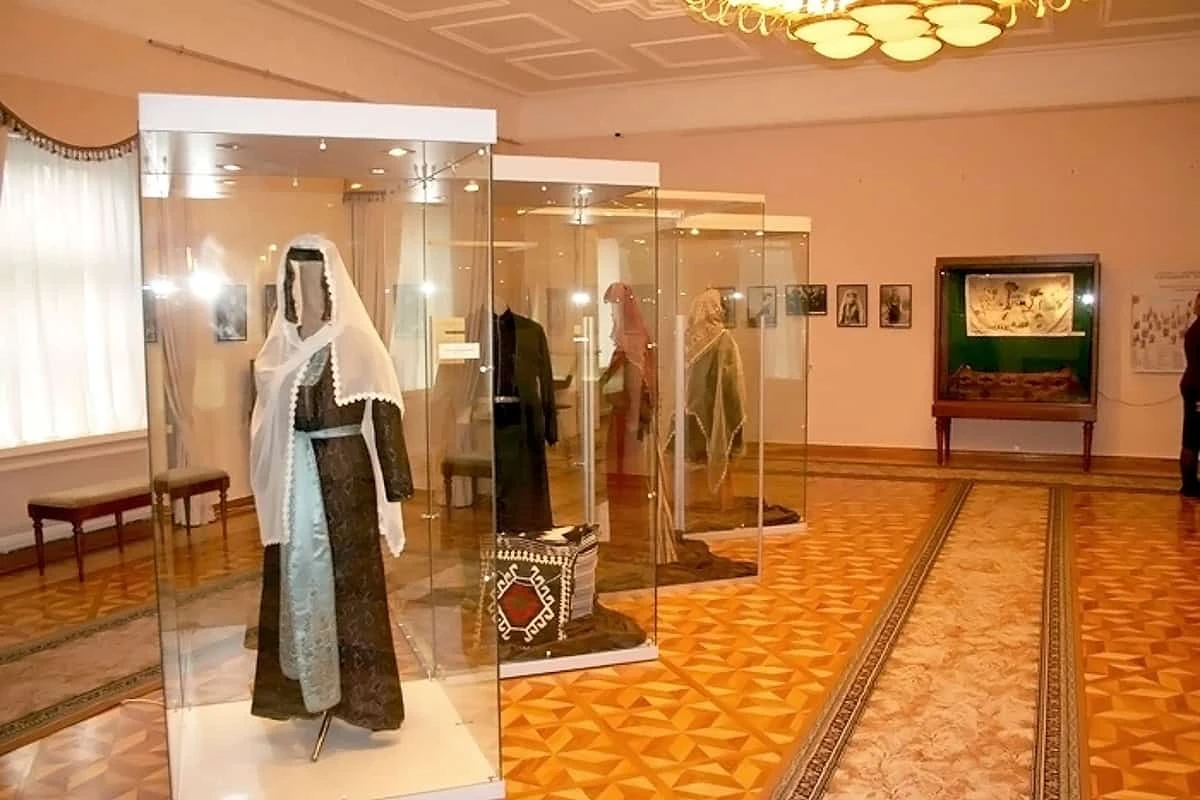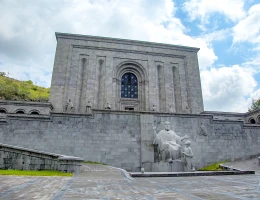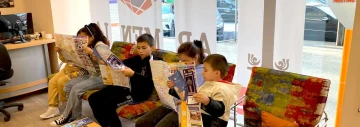The best place to study the history, culture and traditions of countries is in museums. Here you do not just get acquainted with dry data, but also see with your own eyes evidence of past centuries that have survived to present day. We have prepared for you a list of the most interesting museums of Yerevan, from large state museums to small thematic ones.
TOP 5 Must Visit Museums
We have included in this list museums that will help you get acquainted with the history of Armenia and Yerevan, see the culture and local traditions, as well as learn about the dark pages of the Armenian past. Overall, these are must-see for those who have come to Armenia for the first time.History Museum of Armenia

History Museum of Armenia
It is the first museum of the Republic of Armenia, founded in 1919, the most popular one in the country. Unique archaeological exhibits are presented here, starting from prehistoric times.
In the permanent exhibition "Stone Age" one can see ancient tools and weapons created about half a million years ago, it is difficult to even imagine such a period. We recommend observing the collection of artifacts of the ancient state of Urartu, which was one of the most powerful in the Ancient East and perished in the 6th century BC.In addition, there is a large collection of Armenian national costumes of the 18th-19th centuries, as well as separate pieces of clothing and jewelry. A separate exhibition examines in detail the art of the Armenian carpet of the 14th-20th centuries, comparing it with sculpture and miniature. Consecrated symbols are hidden in the ornamental patterns, "reading" which, one can get an idea of the beliefs and cults of that period of time.
The museum is located on the Republic Square, behind the singing fountains. It is open from Tuesday to Sunday, and closed on Monday.
National Art Gallery of Armenia

National Art Gallery of Armenia
It is located in the same building as the History Museum of Armenia. The museum occupies floors 3-8. This is one of the most amazing museums in the country, one of the largest in the CIS, a favorite place for all art lovers. Visitors to the gallery note the magnificent gallery of frescoes, the largest collection of Armenian art in the world, as well as a wonderful collection of works by Aivazovsky. The Italian collection includes originals by Tintoretto, F. Guardi, A. Turki, G. Cavedone and other masters. In the Dutch and Flemish collection, one can see originals by the great Peter Rubens, Jan van Goyen, as well as Caspar Netsche. The gallery also has a fairly large collection by French artists: Jean Fragonard, Francois Drouais, Jean Baptiste Greuze.In the collection of decorative and applied art, one can view masks, figurines and fabrics created in the 2nd-7th millennia BC. In addition, the gallery contains examples of sculpture created in the workshop of Donatello, Luca della Robbia and other great sculptors.
The gallery is located in the Republic Square, behind the singing fountains. Like the museum, the gallery welcomes visitors from Tuesday to Sunday, and is closed on Monday.
Erebuni Museum and Fortress

Erebuni Museum and Fortress
"The Erebuni Historical and Archaeological Museum-Reserve" is an important cultural and scientific center dedicated to the ancient history of the fortress city of Erebuni, founded in 782 BC by the Urartian king Argishti I. The museum was opened in 1968, timed to coincide with the 2750th anniversary of the foundation of the city.
The excavations of the fortress on Arin-Berd Hill, which began in the 19th century and intensified in the 1950s, led to the discovery of number of unique archaeological finds, including cuneiform inscriptions about the foundation of Erebuni, as well as items dating back to the Urartian, Hellenistic and early Armenian periods.The museum collection includes about 12.000 artifacts, among which stone and clay statues, bronze items with cuneiform inscriptions and weapons stand out. The artifacts of the museum are regularly exhibited in famous world museums such as the Louvre and the Hermitage. It is visited by about 15.000 tourists annually, and classes in the Urartian language are held as part of the educational program.
The Erebuni Museum is located at 38, Erebuni str. It is open from Tuesday to Sunday, Monday is a day off.
Tsitsernakaberd Memorial Complex and The Armenian Genocide Museum

Tsitsernakaberd Memorial Complex
It is a monument dedicated to the tragic pages of Armenian history. The purpose of the complex is to preserve the memories of the 1.5 million Armenians who died during the Genocide of the 20th century. In 2014, Forbes magazine named the museum among nine that everyone should visit.
The Armenian Genocide is the forced deportation in conditions impossible to survive in ("death marches") and mass murders of residents of the territories under the control of the Ottoman Empire. The authorities planned to completely clear the regions populated by Armenians.The museum is located underground and occupies two floors. It contains many documentary evidence of the events that took place in those years: photographs of the killed and caravans of refugees, evidence of torture, letters, as well as other documents.

The Armenian Genocide Museum
The Tsitsernakaberd Memorial Complex attracts attention with a 44-m high stele. If you come closer, you can see a crack from the base to the top: a symbolic representation of the divided Armenian people. Nearby: a stone cone with an Eternal Flame in the center. The complex is located on a hill with beautiful views of Yerevan and Mount Ararat. It is located not far from the Republic Square, a walk will take less than an hour.The museum is located at the address of 8/8, Tsitsernakaberd highway. It is open from Tuesday to Sunday, while Monday is a day-off.
Matenadaran – The Museum of Ancient Manuscripts

Matenadaran
It is one of the largest repositories of manuscripts in the world. The museum-institute is named after the creator of the Armenian alphabet, Mesrop Mashtots.Inside, in 15 halls, thousands of exhibits are presented. Among them are old songbooks, poems, illustrated editions about the structure of humans and animals, biographies that were written many centuries ago – real works of art.
The history of book printing in the world is described here in detail, one will also find many interesting religious publications. In addition, here one can view the largest book, "Msho Charentir", which weighs almost 30 kg, and the smallest: "Tonatsuyts", weighing less than 20 grams. The preservation of the manuscripts is stunning, even the most ancient ones, dating back to the 5th-6th centuries, have reached our days in relatively good condition.The museum is located at 10-minute walk from the "Cascade" at 53, Mashtots Ave. It is open from Tuesday to Saturday, Monday and Sunday are days off.
Interesting thematic museums of Yerevan
In addition to general historical museums, Yerevan also has museums with a narrow focus. We will tell you about those that seem the most interesting to us."ARARAT" Museum and Brandy Factory

ARARAT Museum and Brandy Factory
The cognac of the "ARARAT" factory is one of the calling cards not only of Yerevan, but of the whole Armenia. It has been produced since the 19th century with the usage of classic French technology. The legendary blends "Dvin", "Yerevan", "Akhtamar" still receive the highest marks from connoisseurs of this strong drink. One can learn its history, as well as try the best varieties during a tour in "ARARAT" museum.
Guides will tell you how grape alcohol is produced, how cognac is stored and aged, where the barrels are brought from and what kind of wood is the best for them. The tour ends with a tasting and a visit to the brand store, where one can buy favorite cognac for himself/herself and a gift for friends.The address of the museum: 2, Admiral Isakov Ave. It is open daily.
Megerian Carpet factory-museum

Megerian Carpet factory-museum
It is a factory and a museum where you can watch the process of making hand-made carpets. The factory specializes only in the mentioned technique, using natural raw materials and dyes. The dyes are obtained from plants, they are fixed with a secret composition based on alum, limestone and other ingredients. It is said that in this way the carpet will not lose its color for centuries: and there is real evidence of this: the oldest exhibit in "Megerian" museum is a carpet that is more than 400 years old.The collections feature items that tell their own story. For example, one of the carpets helped reunite a family that survived the Armenian Genocide. The sisters, forced to separate, took half with them, and then recognized each other in New York by them.
The museum is located at the following address: 9, Madoyan str., not far from the monument to David of Sassoun. It is open from Monday to Saturday, and closed on Sunday.
Yerevan History Museum

Yerevan History Museum
Yerevan is a city that is almost 3000 years old. The official date of foundation is 782 BC, but people used to live here even earlier, according to researchers, 3000 years BC. In the History Museum one can see all the stages of the formation and development of the capital of Armenia, from the ancient city-fortress of Erebuni to the present day. The oldest exhibits date back to prehistoric times, for example, Shengavit ceramics are presented here – it is older than the Egyptian pyramids, the Shengavit settlement itself existed in the 4th-2nd millennia BC. The museum also has a large collection of coins from Byzantium, Ancient Rome, Ancient Greece, as well as other countries found during excavations on the territory of present-day Yerevan.In addition, the museum holds interactive games and educational programs for children and adults to get to know the city better and learn about events that are not written about in tourist guides.
Yerevan History Museum is located at the following address: 1, Argishti str., at 15 minutes walk from the National Art Gallery of Armenia. It is open from Monday to Saturday, and is closed on Sunday.
Lusik Aguletsi house-museum

Lusik Aguletsi house-museum
Lusik Aguletsi is an artist, collector and keeper of Armenian traditions. She used to collect traditional Armenian costumes and walked around Yerevan in national garbs. Her house-museum presents a large collection of antique dolls, household items, jewelry collections and much more. People come to her house to immerse themselves in the past, learn about local legends and see ritual objects, feel the spirit of that time and understand how Armenians lived before. And one can discuss impressions obtained in the art cafe: in the summer, the tables are taken out into the garden, while in the cold season it's usual to sit on the second floor among the exhibits.The address of the house-museum: 79, Muratsan str. It is open daily, seven days a week.
Sergey Paradjanov Museum

Sergey Paradjanov Museum
Sergey Paradjanov is a Soviet director, real name: Sargis Hovsep Paradjanyan. He is known for the films "The Color of Pomegranates", "Ashik-Kerib", "Shadows of Forgotten Ancestors". A creator and artist himself (his installations can be seen in the museum), Paradjanov used to create amazing sets for filming. His difficult life story and creative development can be observed in the museum halls. Visitors say that it is not needed to book a tour here, one can walk on his/her own. The place is so "speaking for itself" that it seems as if Paradjanov himself is talking about his life. To visit here, one does not have to be a fan of his films: if you like unusual, creative personalities and their ways of self-expression, then you are welcome to visit. You will get ideas for inspiration and see how to create masterpieces from ordinary things.The museum is located at the following address: 15/16, Dzoragyukh str., not far from the "ARARAT" Museum. It is open daily.
Martiros Sarian House-Museum

Martiros Sarian House-Museum
In this museum one will feel as if appearing in another world – painted with Sarian's colors. He was called a master of color for his rich, bright shades and unreal landscapes.
He became one of the founders of national Armenian painting, conveyed fairy tales and dreams in his works, showed his love for Armenia and impressions of travel through paintings. By the way, his great-granddaughter is the writer Mariam Petrosyan, the author of the book "The Gray House".The museum displays not only Sarian's outstanding works, but also his personal painting accessories, photographs, as well as household items. The interior in which the artist lived has been completely preserved in the residential part of the house. He received recognition during his lifetime, so the furnishings, although modest in appearance, are quite rich.
The museum is located at the following address: 3, Sarian str., not far from "Cascade". It is open every day except on Thursday.
This is not a complete list of museums of Yerevan. As you get to know the city further, you will find and learn about new art galleries, museums dedicated to renowned people, souvenir shops with works by local artisans and much more. But those listed above, in our opinion, can be considered the best ones in the capital of Armenia. Contact us, and we will tell you more about each one and create an individual route for your trip.












